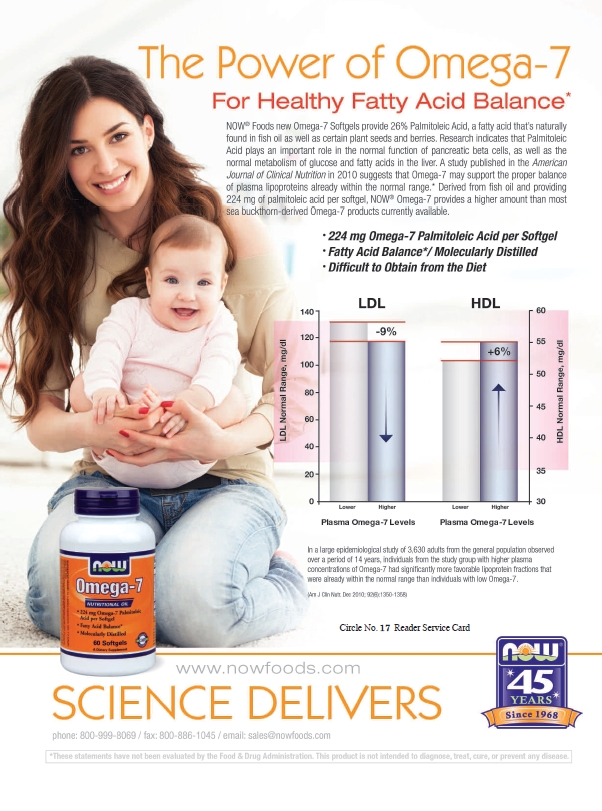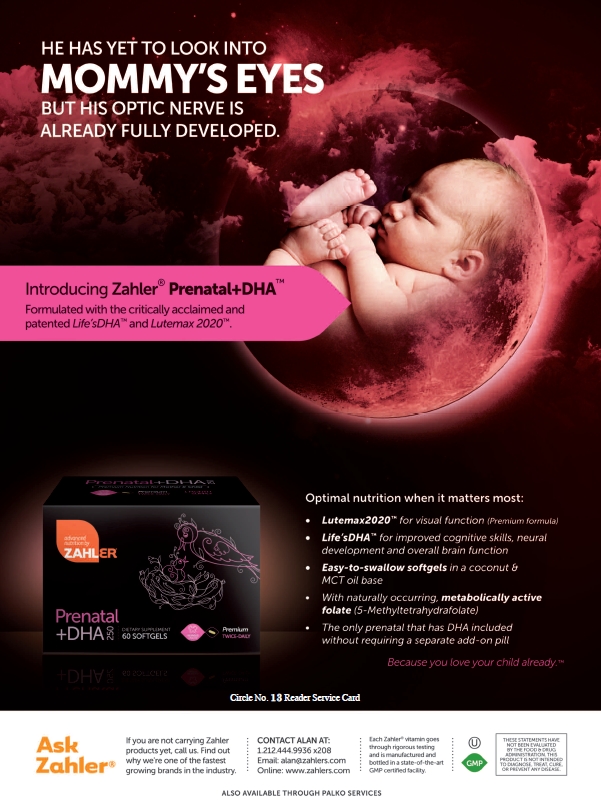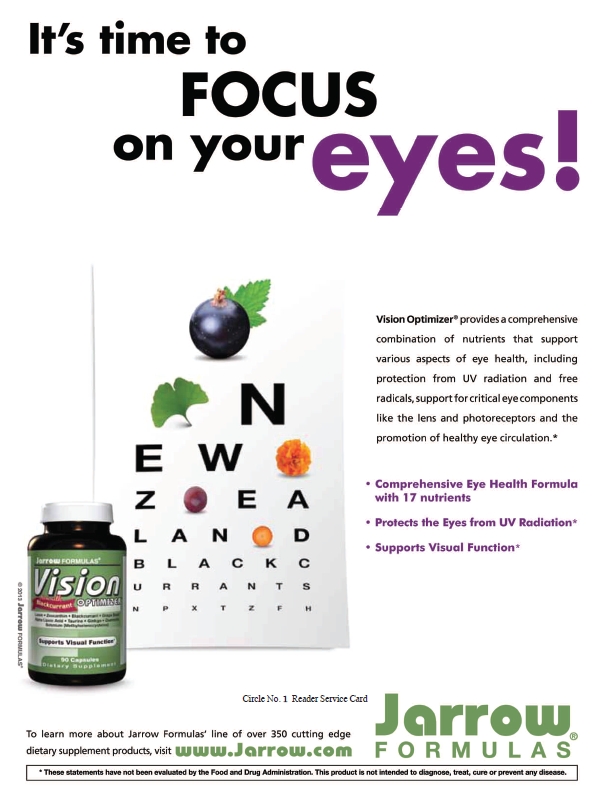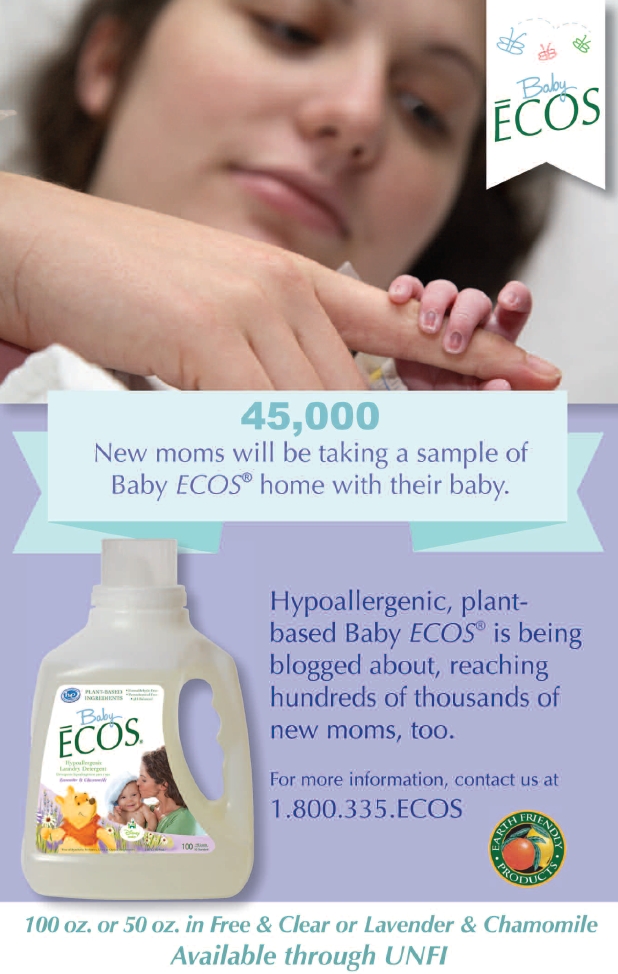A child’s first years are marked by countless milestones, from rolling over to learning letters to taking their first steps—followed quickly by taking their first run. Proper nutrition—which includes smart dietary choices and taking natural and organic supplements—can make a child better able to handle the rapid physical and mental growth he or she undergoes during this important developmental period. Here’s how your store can support your tiniest clients at each stage of the game.
Beyond Nine
We know that a mother’s nutrition during her nine months of pregnancy is essential to the baby’s growth and development in utero. But what many women don’t fully realize is that her food choices and the decision to take natural or organic supplements while pregnant have a much longer-lasting effect that reaches beyond when the cord is cut.
Alan Assael, director of sales at Advanced Nutrition by Zahler, Inc., Brooklyn, NY, says everything from an infant’s birth weight to adult chronic conditions can be tied to his/her mother’s prenatal nutrition: “There is no greater opportunity to impact the health, aptitude, and developmental potential of a human being than in the formative gestational stage.” Indeed, new research shows a convincing connection between prenatal nutrition and a child’s health down the road.
First, it’s been well established that a baby’s  brain, heart and eye development are boosted with adequate prenatal intake of omegas. But Herb Joiner-Bey, scientific advisor to Barlean’s, Ferndale, WA, tells us something you may not know: omega-3 deficiency during pregnancy may inadvertently turn on the genes associated with obesity in the baby. “That means the child is much more likely to become obese years later and suffer the adverse complications linked to obesity, such as type-2 diabetes,” he states. That’s not all: omega-3 deficits in a pregnant woman may increase the chance her child will have immune system imbalances like allergies.
brain, heart and eye development are boosted with adequate prenatal intake of omegas. But Herb Joiner-Bey, scientific advisor to Barlean’s, Ferndale, WA, tells us something you may not know: omega-3 deficiency during pregnancy may inadvertently turn on the genes associated with obesity in the baby. “That means the child is much more likely to become obese years later and suffer the adverse complications linked to obesity, such as type-2 diabetes,” he states. That’s not all: omega-3 deficits in a pregnant woman may increase the chance her child will have immune system imbalances like allergies.
Suzanne Munson, M.S., director of product development for Fairhaven Health, Bellingham, WA, adds, “Recent research has shown that pregnant women who supplemented with DHA…experienced longer gestation times, healthier birth weights and fewer premature births.”
The research community has also been interested in the connection between prenatal intake of omega-3s and a child’s language development, mental focus and behavior, and Jolie Root, nutritionist at Carlson Laboratories, Arlington Heights, IL, points us to several studies on the topic.
• A study of 154 children found that those who had higher levels of DHA in their umbilical cord at birth had better memory function at age 11. “This study provides the first neurophysiologic and neurobehavioral evidence of long-term beneficial effects of n-3 PUFA intake by expecting mothers on memory function in school-age children,” states Root.
• Also looking at DHA levels in cord blood, a 2011 study of healthy pregnant women from Spain, Germany, and Hungary found higher levels of DHA were linked with better neurological outcomes in offspring at 5.5 years of age (1).
• Another 2011 study found having “superior” omega-3 status during pregnancy was associated with a lower risk of the child being overweight or obese at age three (2).
•And in 2009, a study of 306 children found that their mothers’ intake of DHA during pregnancy was associated with better motor function at age seven (3).
But omegas aren’t the be-all-and-end-all of brain support; data indicate prenatal folic acid should also be on women’s radar for this purpose. Long known as an effective tool for thwarting neural tube defects (like spina bifida), women of childbearing age have been advised to take folic acid supplements before pregnancy since this vitamin is so essential to a young fetus’ development as early as a few weeks after conception. Says Munson, “Most prenatal vitamins include folic acid, part of the vitamin B family, which is very important for healthy fetal development . . . Neural tube defects often occur in the first three to four weeks following ovulation/fertilization, so adequate folic acid intake prior to pregnancy is important.”
support; data indicate prenatal folic acid should also be on women’s radar for this purpose. Long known as an effective tool for thwarting neural tube defects (like spina bifida), women of childbearing age have been advised to take folic acid supplements before pregnancy since this vitamin is so essential to a young fetus’ development as early as a few weeks after conception. Says Munson, “Most prenatal vitamins include folic acid, part of the vitamin B family, which is very important for healthy fetal development . . . Neural tube defects often occur in the first three to four weeks following ovulation/fertilization, so adequate folic acid intake prior to pregnancy is important.”
But there’s more to folic acid. In April, WholeFoods published the results of a large Norwegian study in which women who took folic acid before conceiving and early in pregnancy were less likely to have a child with an autistic disorder (4). This isn’t isolated research. Root points us to a 2011 study in which mothers who took folic acid supplements in early pregnancy gave birth to children with a reduced risk of severe language delay at three years old (5). She states, “We continue to see evidence linking nutrient status during pregnancy to attainment of important developmental milestones in children.”
Zinc is not often given much attention in prenatal nutrition, but Root feels some research supports its use for a child’s heart health down the road. A 2010 study involved 165 children whose mothers either took a combination of 25 mg of zinc, 60 mg of iron and 250 mcg of folic acid everyday while pregnant, or just iron and folic acid during pregnancy. At four-and-a-half years old, children whose moms took zinc had a slower heart rate, greater range, higher variability in heart rate and better vagal tone (6).
 These were just a few examples of new research indicating the long-term effects of prenatal nutrition. Women who are pregnant, or planning for a family, should take a prenatal multi so all their needs are covered. Though taking a prenatal before conception may seem a bit premature, Trisha Sugarek MacDonald, B.S., M.S., director of research and development and national educator for Bluebonnet Nutrition Corporation, Sugar Land, TX, says it’s the right thing to do because babies grow at a rapid pace—even during the few days and weeks before a pregnancy is confirmed. “Plus, it’s not just any type of nutrient; it’s the right nutrients in the right amounts as well as in the right balance—especially vitamins, minerals and essential fatty acids,” she says of prenatals, noting that the daily values for some nutrients are doubled during pregnancy. “Deficiency or excess of any number of these nutrients can lead to complications during pregnancy for the mother and the developing child.”
These were just a few examples of new research indicating the long-term effects of prenatal nutrition. Women who are pregnant, or planning for a family, should take a prenatal multi so all their needs are covered. Though taking a prenatal before conception may seem a bit premature, Trisha Sugarek MacDonald, B.S., M.S., director of research and development and national educator for Bluebonnet Nutrition Corporation, Sugar Land, TX, says it’s the right thing to do because babies grow at a rapid pace—even during the few days and weeks before a pregnancy is confirmed. “Plus, it’s not just any type of nutrient; it’s the right nutrients in the right amounts as well as in the right balance—especially vitamins, minerals and essential fatty acids,” she says of prenatals, noting that the daily values for some nutrients are doubled during pregnancy. “Deficiency or excess of any number of these nutrients can lead to complications during pregnancy for the mother and the developing child.”
For instance, Sugarek MacDonald explains that B-vitamins and iron are essential because a pregnant woman’s blood volume increases 40–50%, and also because folic acid is needed to seal the neural tube and prevent defects.
Before leaving the prenatal period, let’s remember that skincare can be an important consideration during this time due to stretching, discoloration and dryness. Stretch marks, for instance, are particularly common. States Jentri Provenzano, product expert and educator at W.S Badger Company, Gilsum, NH, “Since stretch marks occur because the skin isn’t elastic enough to accommodate a major change in shape in a short amount of time, it makes even more sense to me that you would treat it topically with a nutrient-rich, organic botanical oil or butter.”
She suggests cocoa butter for skin suppleness and elasticity, especially cold-pressed cocoa butter. “This is because—unlike the cocoa butter byproduct created by the chocolate industry (which uses a lot of heat)—cold-pressed cocoa butter retains its theobromine content, as well as its delicate balance of nutrients and essential fatty acids.” She adds that cold-pressed cocoa butter contains oleic acid (omega-9), palmitoleic acid (omega-7) and linoleic acid (omega-6), “all of which are very nourishing to the skin,” and helps with an itchy belly caused by dryness and stretched skin.
Provenzano is also a fan of body oils. “I think that  the key to keeping skin healthy and beautiful during pregnancy is using an organic, healthy oil to aid the skin as it stretches,” she states.
the key to keeping skin healthy and beautiful during pregnancy is using an organic, healthy oil to aid the skin as it stretches,” she states.
Meanwhile, Jennifer Norman, vice president of marketing at derma e, Simi Valley, CA, tells us about how one might handle spider veins: “There have been several recent studies showing that horse chestnut can be beneficial to address spider veins.”
Milk Making
According to the Centers for Disease Control and Prevention (CDC), breastfeeding rose 2% (from 74.6% 2008 to 76.9% 2009) in breastfeeding initiation, and at six (from 44.3% to 47.2%) and 12 months (23.8% to 25.5%) (7).
Women choose to discontinue breastfeeding for a variety of reasons, but there are many that stop or slow down because of milk supply issues. For those that turn to natural galactogogues, there are several options.
Fenugreek is one well-known herb for breastfeeding support, and Sugarek MacDonald explains why: “Fenugreek, containing saponins, has demonstrated efficacy in the scientific literature as a galactagogue…These active constituents are considered galactagogues, which are substances or medications believed to stimulate initiation, maintenance and augmentation of milk production.” This effect may be caused by its phytoestrogen and diosgenin content.
If women are buying this supplement from you for the first time, let them know they “can see an increase in milk production within the first two to three days after beginning supplementation with fenugreek, with full effectiveness within two weeks,” says Munson.
 One potentially frustrating thing about taking fenugreek is that many formulas require four or more separate doses daily. Sugarek MacDonald says, “the greatest concentration of saponins in fenugreek come from its seed.” For this reason, her company offers standardized fenugreek seed extract, “providing 120 mg/serving of total saponins, which is in line with the amount shown in research to stimulate maternal milk production in women who want to breastfeed.” Therefore, far fewer capsules are needed.
One potentially frustrating thing about taking fenugreek is that many formulas require four or more separate doses daily. Sugarek MacDonald says, “the greatest concentration of saponins in fenugreek come from its seed.” For this reason, her company offers standardized fenugreek seed extract, “providing 120 mg/serving of total saponins, which is in line with the amount shown in research to stimulate maternal milk production in women who want to breastfeed.” Therefore, far fewer capsules are needed.
Likewise, Muson’s company just launched a fenugreek seed extract that requires just two capsules per day.
Other possible galactogogues include fennel, nettle, blessed thistle, milk thistle and goat’s rue, the latter of which may stimulate mammary tissue and increase breast milk when breast tissue did not increase during pregnancy. Many companies find women have success when several ingredients are combined into one lactation-support product. For instance, Assael says a formula from his company (Lactation Success) contains 2,000 mg of choline, 4,800 mcg of folic acid, red raspberry, stinging nettle and 2,400 mg of vitamin C per serving. “The goal is to get the reproduction system back on track after birth and aid in the production of quality milk,” he explains.
Don’t forget to remind breastfeeding women to get enough vitamin D. States Munson, “Current research indicates that many women are vitamin D deficient, which means their breast milk might be low in vitamin D as well.” Given D’s importance to bone health, immune health, dental health and more, using natural or organic supplements is very important.
After four to six months of exclusive breastfeeding, Sonia Schiess, Ph.D., partner and chief nutritionist at Amara Baby Food, says infants need to complement their food intake and to ensure adequate nutrition and growth.
"Energy and protein need to be supplied, as well as micronutrients like iron, zinc, magnesium or vitamins (like B, D and niacin)," she states. "The infant starts with small quantities of complementary foods, which should be nutrient dense (many nutrients per energy intake), to cover the requirements. Further, the infant must change their eating habits, fromsucking to swallowing and later to chewing." And, that's where the burgeoning natural and organic baby food category comes into play.
|
Select Prenatal/Babies/Toddlers Product Offerings
Advanced Nutrition by Zahler: Lactation Success, Zahler Prenatal+DHA (original and premium formulas), Kidophilus and Total One Prenatal. Amara Baby Food: Pouches of powdered freeze-dried organic fruits for stage 1 (apple and banana) and stage 2 (apple-maqui berry). |
|
First Spoonfuls
A 2013 survey of U.S. families with kids found that 81% of households are buying organic products at least part of the time (8). The trend is clear, as the organic baby and toddler food category is exploding. Makers of organic baby foods are meeting the expanding category head-on by getting creative with flavors and nutrition. “We commonly use nutritious grains like quinoa, barley and oatmeal,” states Geoff Stella, vice president of marketing at Sprout Foods, Duluth, GA. “More unique, but still nutrient-rich, ingredients in our recipes include acai, blackcurrant, lentils, white beans, coconut, zucchini and spinach.”
Meanwhile, Shazi Visram, founder of Happy Family, Brooklyn, NY, says her company works with pediatricians and registered dieticians to formulate foods. The result is the addition of ingredients you may not find in your run-of-the-mill baby/toddler product. “For example, we add vitamin D to many products because the majority of children under age four are deficient in vitamin D,” she says, adding, “We also add innovative nutrition boosters, like Salba (nature’s most nutritious whole food), probiotics and choline for brain development.”
Since parents are increasingly aware of the dangers of synthetic additives, Visram recommends offering products that are certified organic. As for non-GMO offerings, she adds that her company was “the first baby/toddler company to officially support the ‘Just Label It’ campaign.”
Learning how to navigate options is something with which retailers can help new parents and caregivers, though parents should work with their pediatricians for tailoring needs to their children, says Visram. “The general rule, though, is to introduce one new food at a time to make sure that you are able to identify any allergic reaction, and obviously wait on the chunkier stuff until baby is gumming food,” she states.
Schiess recommends starting with single-ingredient foods like fine-pureed fortified cereals, fruits or vegetables and then adding new varieties one by one to prevent and test possible food allergies.
Stella explains that the numbered stages on baby food products help bring some clarity, starting with the first solids. These include easily digestible foods like whole grain, instant cereals and single-ingredient purees. “Additionally, our single-ingredient focus allows parents to test for allergic reactions to various foods,” says Stella.
One tip from Visram is that once a baby does well with his/her cereal and some single-ingredient, simple veggie or fruit purees, parents can mix them.
Stage Two adds in more ingredients and sometimes a slightly thicker texture. Stella says rather than just traditional fruit/veggie mixtures, companies are upping the ante with some adventurous ingredients. The Sprout line, for instance, uses mango, spinach, pumpkin, quinoa and zucchini. Last, Stage Three has more texture and heartiness so that chewing is required. “Our recipes are chef-inspired, so recipes like Minestrone & Greens with Beans and Spiced Apple Rice Pudding with Zucchini will give baby an opportunity to explore wonderful flavor combinations,” says Stella.
Last, toddler foods add in even more flavors and more adult textures. Some trends among companies are superfruits, Greek yogurt and healthier versions of staples like a macaroni and cheese with butternut squash from Sprout.
Meanwhile, Amara Baby Food mixes familiar (apple) with exotic (maqui berry) for a unique, nutrient-dense meal. "As a tribute to Patagonia and in order to boost nutrition, we incorporated in our 7+ month Apple Maqui Berry flavor the Maqui Berries (Aristotelia chilensis). The maqui berries come from our own backyard, the pristine Patagonia, and are rich in antioxidants giving your baby the protection he/she needs by enriching the dish with valuable vitamins, minerals and antioxidants," states Schiess.
Toddler Time
No matter how much a parent may try to serve nutritious foods at every meal, kids’ diets—like the rest of ours—will always have gaps. When it comes to supplements, however, retailers should be careful with over-recommendations; a baby’s or toddler’s nutrition should come from foods first, and then natural or organic supplements. States Claire Polson, national sales and marketing manager at Hero Nutritionals, San Clemente, CA, “We do not recommend and always defer to the specialists and physicians of the families as each nutritional need is unique for the person. We do advise the child must be able to chew and swallow with no adverse effects, including choking.”
But depending on the parents’ view on supplements and the advice of their healthcare professional, Joiner-Bey believes youngsters can start during infancy once they start eating solids. But, he warns, “Dose carefully to avoid overwhelming the child’s metabolic systems.”
Companies have several options for parents. Craig Klein, M.S., L.N., C.N.S., national educator at Michael’s Naturopathic Programs, San Antonio, TX, says his company makes a multivitamin formula for ages one through three that benefits immune health. He states, “It is important to provide the B-complex vitamins plus vitamins A, C and D particularly for their role in supporting the immune system. Zinc is also very important for this.”
Joiner-Bey points out that boosting a child’s vitamin intake doesn’t only involve a multivitamin. Parents may prefer to mix powdered greens into juice, water, smoothies and the like. He states, “Greens concentrates are the most basic of nutritional supplements and have the widest range of micronutrients (vitamins, minerals, carotenes, flavonoids), as well as under-appreciated ‘food accessory factors’ and ‘growth factors’ essential to optimal childhood development.”
Vitamin D has gotten a lot of attention recently since so many children and adults are sorely lacking in this vital bone-, cognitive- and immune-support vitamin. Root says for breastfed babies, 400 IUs of D “starting soon after birth is recommended because breastfed infants generally do not obtain adequate vitamin D from other sources.”
|
Cloth Diapering Myth Busters Cloth and eco-friendly disposable diapers are increasing in popularity. And as with many trends, there’s also an increase in misconceptions. Retailers who stock cloth or hybrid systems can help shoppers get the correct facts. Options are limited. Nope, there is more diversity in this market segment than ever, and retailers can stock what makes sense for their bottom line and clientele. Says Kim Ormsby, founder and chief innovator of GroVia, Bozeman, MT, “To start, we recommend shoppers do as much research as they can to see which brand and type will fit their lifestyles best. Some cloth diapers are made to be as easy as possible to use, while others are designed to be flexible for use at daycare or while traveling, and still others are perfect for nighttime use.” Chlorine-free disposables are a given for parents that choose not to go the cloth route. Hybrid systems often have a cloth, reusable shell into which disposable inserts are placed. Some inserts are compostable or flushable. Then, there are pocket diapers that have the reusable shell with washable absorbent inserts. All-in-one diapers (sometimes as pocket diapers or with attached inserts) have a system of snaps or Velcro that can be resized easily to “grow” with the child. Traditional pre-folds and flat diapers are another option, and often are paired with waterproof covers. They’re expensive. A typical bag of chlorine-free disposable diapers may cost about $15 for, say, a couple dozen diapers. A cloth diaper may cost $15–20 each. That’s enough to stop some parents from moving forward with buying the 24+ they need for full-time cloth diapering. “In terms of cost, although the initial start-up cost of cloth diapers is usually significant, most families will end up saving anywhere from 50% to 75% over a child’s diaper-wearing years when compared to using disposables,” according to Ormsby. “The savings can easily add up to $1,000 or more…and gets much larger if the same cloth diapers are well maintained and can be used on multiple children.” Cleaning them requires too much water. Yes, cleaning cloth diapers uses water that disposables don’t require. But, disposables have the waste factor to consider. According to Ormsby, U.S. families throw away a combined 20 billion disposable diapers annually. “This makes disposable diapers the third largest source of household waste in this country,” says Ormsby, adding that many of these are conventional products made with plastic and chlorine. She says that though water is needed to wash the cloth variety, the industry process needed to make disposables requires a huge amount of water, not to mention a significant amount of petroleum (to make the plastic used in disposables), bleaches, artificial fragrances and wood pulp. Regarding cleaning, retailers should talk to their manufacturers for advice about what to tell shoppers. “Correctly caring for cloth diapers is extremely important for ensuring that they work properly and that they last for many years,” says Ormsby. “This includes making sure diapers made from organic cotton or hemp materials are properly “prepped”(removing the natural oils found in these minimally processed fabrics to establish the absorbency needed) before using, adhering to washing guidelines that are specific to each product, using the recommended type and amount of detergent, storing the diapers correctly and caring for them in accordance with product guidelines.” |
|
Sugarek MacDonald gives us some stats about the situation: “According to the CDC, about 40% of children ages one to eight years have inadequate vitamin D status.” She says this is especially true of families that live where there is restricted sunlight exposure (north of 42 degrees latitude) or a high level of atmospheric pollution. Sugarek MacDonald says those especially prone to D deficiencies include strict vegetarians, dark-skinned individuals, those who constantly wear sunscreen and anyone who primarily stays indoors.
“In fact, Caucasian children living in the northern United States only achieved the minimal daily dose of vitamin D in the summer months and only if they did not wear sunscreen,” she states. She believes that one can’t rely on sun exposure to meet one’s daily vitamin D requirements, and therefore recommends parents take advantage of the liquid and chewable D supplements on the market that are formulated for children.
Along with D, many parents may decide their child needs calcium in his/her diet to support adequate bone health. Sugarek MacDonald says, “21% of children two to eight years old do not meet their daily requirement of calcium, an essential mineral that helps children reach their peak bone mass.” Kids ages one to three should get 500 mg/day and those ages four to eight should get 800 mg/day (9).
Omegas are another supplement that experts agree should be in a child’s nutritional regimen. As described previously, the eye and brain support benefits of DHA (from fish and algae, and ALA from flax and other sources) are undeniable. Joiner-Bey states, “Omega-3s are critical for optimal brain development, mental clarity, stable mood and learning ability.” To this list, Assael adds improved eye–hand coordination.
Unfortunately, Sugarek MacDonald says many U.S. adults only get about 54 mg/day, and kids consume even less. Therefore, it’s even more important to use natural or organic supplements, and Joiner-Bey explains how: “Dose the child proportionally according to the child’s body weight compared to the average 150-pound adult. Adjust the adult dose downward according to this body–weight ratio.”
One thing companies are careful not to add are artificial sweeteners, fructose, artificial colors and flavors—something many mainstream chewables and gummies are usually laden with.
Baby Soft Skin
Special care must be taken with baby and toddler skin; it’s delicate, still thickening and ever developing. “New baby skin takes time to acclimate to the outside world, and mamas spend a lot of time trying to find the best way to keep baby skin soothed and comforted,” states Melinda Olson, mama in charge, founder/CEO of Earth Mama Angel Baby, Oregon City, OR.
The skin of newborns is thin and vulnerable to environmental toxins, so avoiding chemicals, especially personal care products, food, clothing and cleaning supplies, is key (10). “Since baby skin is so fragile, we think it’s essential for mamas to know exactly what is going on with their babies’ precious skin,” Olson states. This means investigating hidden ingredients like fragrances to ensure a safe product for baby.
Most older infants’ and toddlers’ skin is thickening a bit more, but still not making the melanin, sweat or natural oils required to keep it moist. Therefore, having natural moisturizers at this stage is key.
“Products that contain whole, minimally processed botanical ingredients retain their natural vitamins, antioxidants, essential fatty acids, and other nutrients that benefit skin just as a supplement would,” Provenzano says. For moisture, she favors a baby oil from her company that hydrates with extra-virgin olive oil, jojoba oil, calendula and chamomile. “Minimal, organic ingredients limit the potential for allergic reaction,” she states, noting that staying away from added fragrance is best for a baby’s delicate skin.
For sun protection, she suggests covering up little ones and using a moisturizing mineral sunscreen with zinc oxide or zinc oxide/titanium dioxide mix since “titanium dioxide alone does not provide enough UVA protection.”
But there’s more to consider than just topical skincare products; what about the detergent used to wash the clothing that hugs a baby? Or, the soap that cleans the bottles? Says Kelly Vlahakis vice president of Earth Friendly Products, Winnetka, IL, “It’s important to know that whatever products you use in your dishwasher will leave a slight residue, so you don’t want that residue to be toxic.”
For cleaning baby’s clothing, eating utensils, cups/bottles and so forth, parents should choose products that are free of “formaldehyde (a carcinogen commonly found in cleaning products), 1,4 dioxane (a carcinogen found in most conventional hand dishwashing liquids), phosphates (a toxic water pollutant commonly found in laundry and dish products), petrochemicals (a carcinogen found in most cleaning products), synthetic dyes and perfumes (a toxic allergen) and are made entirely of all-natural plant-based ingredients,” she says.
Be concerned with household cleaners, too. Vlahakis says that indoor air pollutant levels are 5–70 times higher than outdoor air pollutants. “It is critically important both during pregnancy and after your child is born to reduce the harmful chemicals that you and your child are exposed to,” she believes, noting that harmful chemicals may cause asthma, various allergies, cancer, nerve and organ damage and more. WF
Editor's note: For information about natural or organic supplements for children, teens and tweens, click here.
References
1. M.V. Escolano-Margarit, “Prenatal DHA Status and Neurological Outcome in Children at Age 5.5 Years Are Positively Associated,” J. Nutr. 141 (6), 1216–1223 (2011).
2. S.M. Donahue, et al., “Prenatal Fatty Acid Status and Child Adiposity at Age 3 Y: Results from a US Pregnancy Cohort,” Am. J. Clin. Nutr. 93 (4), 780–788 (2011).
3. E.C. Bakker, et al., “Relationship Between Long-Chain Polyunsaturated Fatty Acids at Birth and Motor Function at 7 Years of Age," Eur. J. Clin. Nutr. 63 (4), 499-504 (2009).
4. “DHA, Folic Acid Improve Infants’ Health,” WholeFoods Magazine 36 (4), 12 (2013).
5. C. Roth, et al., “Folic Acid Supplements in Pregnancy and Severe Language Delay in Children,” JAMA, 306 (14), 1566–1573 (2011).
6. L.E. Caulfield, et al., “Maternal Zinc Supplementation during Pregnancy Affects Autonomic Function of Peruvian Children Assessed at 54 Months of Age,” J. Nutr. 141 (2), 327–332 (2011).
7. Centers for Disease Control and Prevention, “Breastfeeding Report Card—United States, 2012,” www.cdc.gov/breastfeeding/data/reportcard.htm, accessed April 13, 2013.
8. Organic Trade Association, “Eight in Ten U.S. Parents Report they Purchase Organic Products,” www.organicnewsroom.com/2013/04/eight_in_ten_us_parents_report.html, accessed April 13, 2013.
9. (Brown, 2005).
10. “How to Choose the Right Ingredients for Your Baby’s Skin,” http://episencial.com/parents-library/stronger-immunity-through-skin-care/baby-skin-stages, accessed Apr. 19, 2013.
Published in WholeFoods Magazine, August 2013











